ANALYSIS: Gov. Hochul’s ‘Bi-Boro’ Train Line: How Will it Work?
12:01 AM EST on January 21, 2022
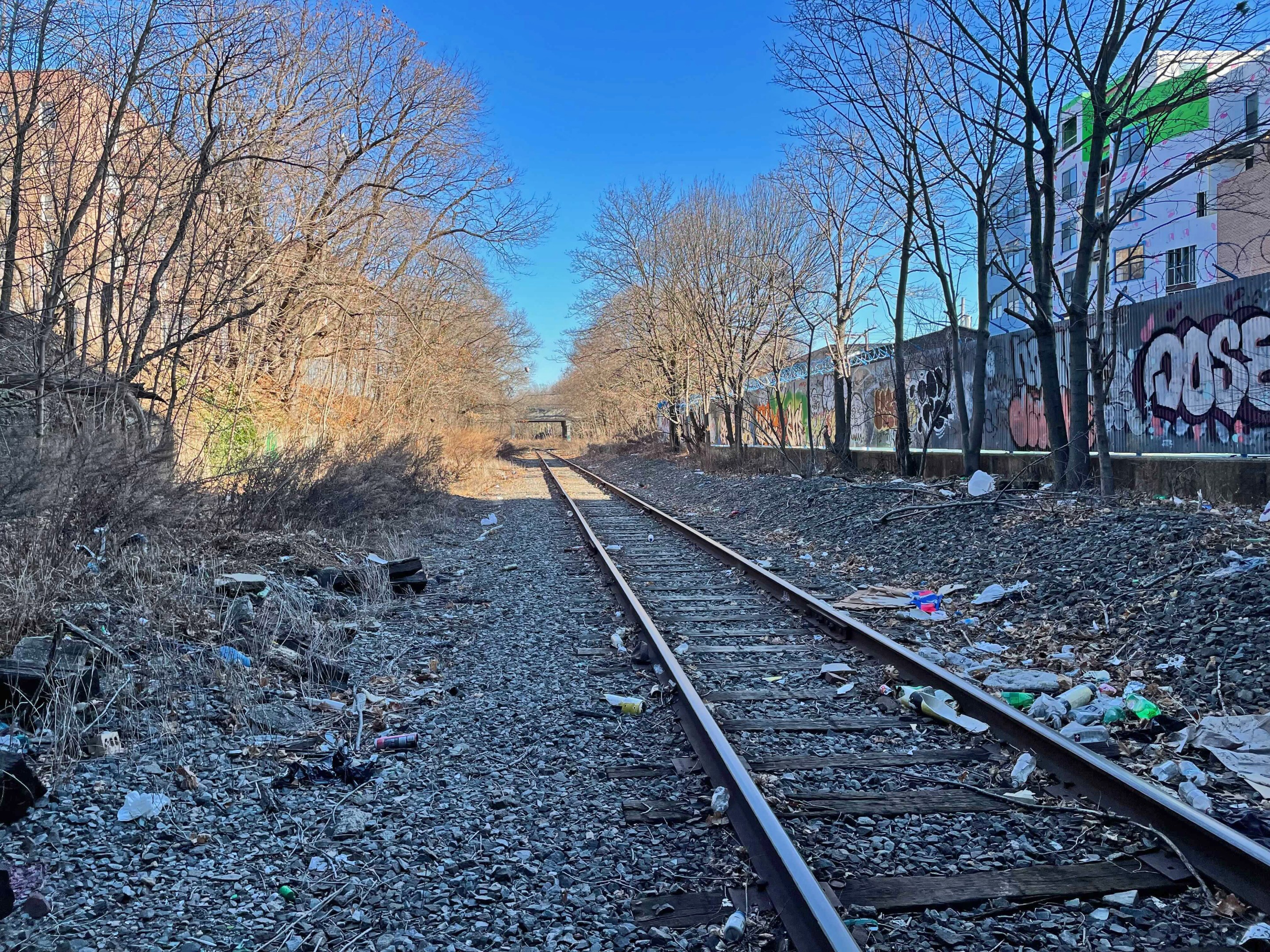
A piece of the Bay Ridge Branch in Brooklyn, looking east. Photo: Dave Colon
New York City is getting a new train line. Maybe. Probably.
Thanks to Gov. Hochul turning into a political champion for passenger service on the circumferential rail right of way that connects Queens and Brooklyn, an all-new honest-to-God Brooklyn-Queens train service is going from urban planner fantasy to honest actual MTA project. But before you start telling your Manhattan friends you never again need to pass through their borough to get where you're going, a few things will need to happen in order to give people rapid, uninterrupted transit service from Bay Ridge to New York City's best neighborhood, Jackson Heights.
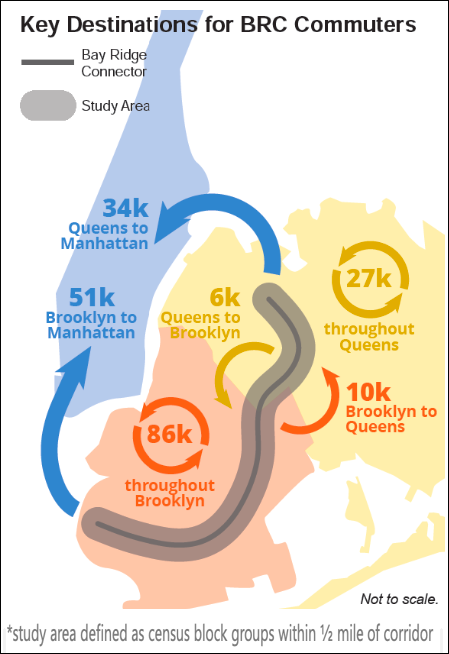
First, how did we get here?
Hochul's project, known as the Interborough Express or IBX, is about two-thirds of a project that the Regional Plan Association has pushed since 1996. Both plans would use an already existing rail right of way to to connect Brooklyn and Queens. Where they differ is that under the RPA vision, the project, known as the Triboro RX, would have run between Bay Ridge and Co-op City. Hochul's version cut the project down, since it's based on a feasibility study done for the MTA by AECOM that explored running passenger service from Bay Ridge to Astoria.
Crucially, when the MTA announced its study in 2020, it tasked AECOM with looking to a future where the right-of-way hosted far more freight traffic than it does currently. Right now, two freight trains per day run between the Bay Ridge train yard and the Fresh Pond Junction in Queens. But Rep. Jerry Nadler (D-Manhattan) has been a long time promoter of a freight train tunnel between New Jersey and Bay Ridge that would greatly boost the amount of freight train traffic that runs on the right of way.
That attention to detail paid off, as Nadler showed up at a press conference about the Interborough on Thursday to bless the project by saying it could coexist with the cross-harbor freight tunnel.
The AECOM-authored study, released on Thursday after FOIL requests from Streetsblog and other outlets, explored three passenger service ideas for the pharmaceutically named IBX, all of which would make a full run in about 45 minutes: light rail, conventional commuter rail cars or bus rapid transit. But questions still remain about how to reconstruct pieces of the right-of-way, making the service work with an increase in freight service and paying for it all in a way that doesn't make your eyes bug out of your head.
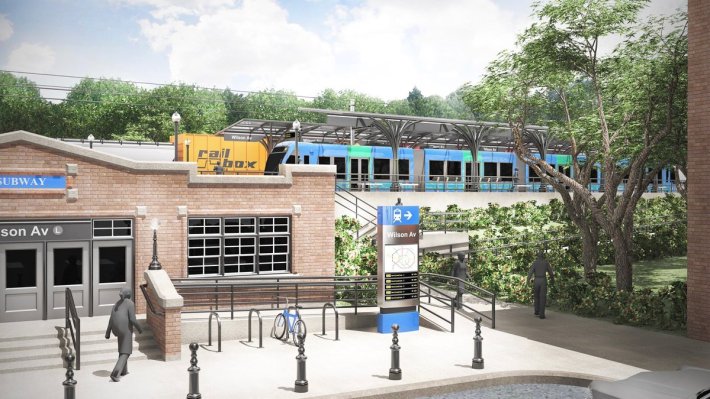
Righting the right-of-way
The Interborough is such an attractive project because a lot of the construction has already been done. The existing right-of-way means that the MTA won't have to spend a few billion dollars digging tunnels through a heavily residential section of Brooklyn and Queens. The MTA's record-setting construction costs (the bad kinds of records) suggest a pretty dire worst-case scenarios if that had to happen. For instance, at the Second Avenue subway Phase 2 cost of $3.9 billion per mile, the 14-mile IBX would cost $54.6 billion.
But just because the MTA doesn't need to worry about tunneling costs doesn't mean there aren't plenty of things to take care before any ribbons can be cut.
The right-of-way is wide enough in some sections for four tracks, but there are places where train tracks have been ripped out and will have to be reinstalled. The right-of-way has also become an overgrown dumping ground in sections that will require cleanup, and future passenger train service means a couple of upgrades for the new and existing tracks: tracks will have to be electrified, and positive train control, a federally mandated train communication system that prevents crashes, will have to installed. At a bare minimum, the areas of the right of way where only one lonely track exists will have to have a second track put in.
"Single track has serious drawbacks. Even if it's just a short section of a line, it's still a bottleneck," said Regional Plan Association Executive Vice President Kate Slevin. "You would have to add tracks, and you have to add places for trains to wait probably in some locations, too. Absolutely you're going to need that kind of infrastructure improvement."
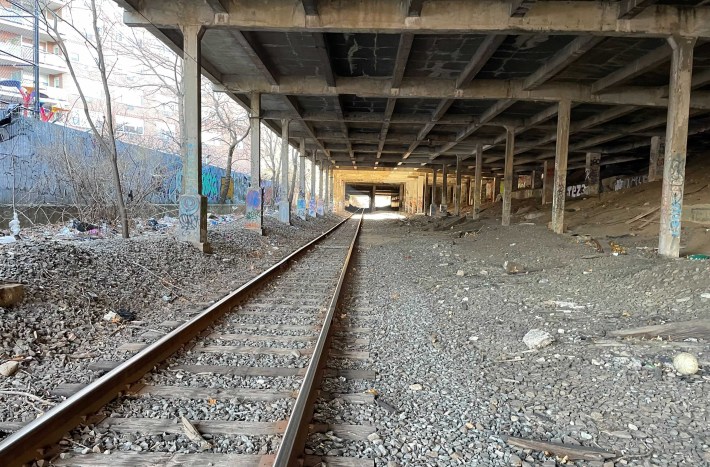
The feasibility study released by the MTA shows that the agency is looking to turn the entire line into a four-track configuration for the commuter or light rail options, though the report does identify areas where "horizontal clearance" is a design constraint that the agency will have to deal with.
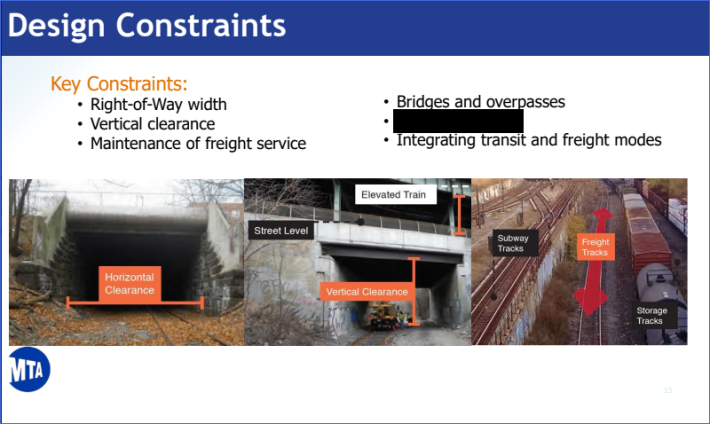
Locomotive coming through
An additional track doesn't solve the other pressing issue of the project, which is how passenger rail service will coexist with current and future freight train service, itself run by a jumble of acronymnical operators.
The Long Island Rail Road owns the right-of-way between the Bay Ridge rail yard on 65th Street in Brooklyn and the Fresh Pond Junction in Queens. The LIRR doesn't run freight itself, instead contracting that right to the New York and Atlantic Railway, which moves freight up the Bay Ridge Branch and then further east to Long Island. NYAR has a handful of customers in the city itself, but also serves plenty of companies that ship and receive goods between the city and the suburbs.
NYAR splits off to the east and west after the Fresh Pond junction, which is a location that comes just before a stop near the Middle Village M train station on a theoretical map of theoretical stations for the Bi-Boro. North of the Fresh Pond Yard, the MTA will have to work out an arrangement with CSX, which owns the right-of-way between Fresh Pond and northern Queens. In a theoretical northern expansion to the Bronx, the MTA would have to work out service issues with Amtrak, which owns the right of way over the Hell Gate Bridge and in the Bronx.
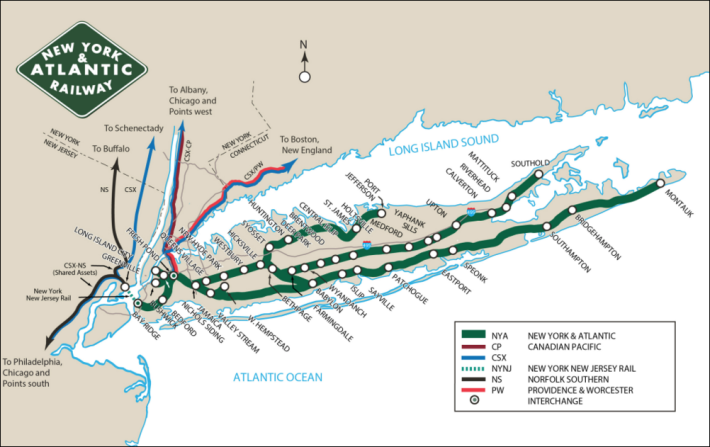
Industry representatives say that preserving access to the Fresh Pond Junction will be of paramount importance even for the existing levels of freight service, since it's a location through which every freight train in the region passes.
There's also the question of expanding freight service on the train tracks, as Rep. Nadler isn't alone in wanting to increase freight's footprint in New York City. The industry itself has sought to grow, with representatives for city freight operations expressing interest in building facilities for their trains along the right of way. New York City's Economic Development Corporation has also promoted both the cross-harbor freight train tunnel and finding more places for "enhanced rail transload facilities" as part of the city's effort to create a more sustainable freight delivery system for New York.
The proposed freight tunnel running under the New York Harbor between New Jersey and Bay Ridge could mean that the Bay Ridge branch goes from running two trains per day to running between 16 and 21 trains per day. The CSX portion of the right-of-way would get between eight and 12 more trains per day in the section north of Fresh Pond. That kind of freight traffic would affect both the possible schedule for passenger service and the types of trains the MTA can use to provide service.
"Historically, one of the problems of sharing freight and passenger tracks are that the freight gets priority," said Tri-State Transportation Campaign Director of Regional Infrastructure Projects Felicia Park-Rogers. "That could create inefficiencies for the passenger service. It can get slowed down or get interrupted, something that's happened on some of the shared tracks in California."
Freight and passenger rail can peacefully co-exist, though. When the RPA issued its 2018 report on the Triboro, the organization noted that the London Overground is a similar expansion of passenger service onto underutilized freight in and around London. The North London Line, an east-west branch that provides both two- and four-track service provides between four and eight trains per hour depending on time of day and section of the line, while still moving 427 million tons of cargo every year.
Although the RPA report on the Triboro suggested that it was possible to run trains every five to 15 minutes on the line, a more realistic scenario is running trains every 10 to 15 minutes. Slevin said that the RPA's map laying out travel time reductions along the line was based on 10- to 15-minute headways, and said that the MTA should stick to that kind of schedule on its own study of the line.
"I don't know what the MTA is going to look at. But ideally, every transit service in the region would be operating at 15-minute or less intervals between trains, because once you get to 20- or 30-minute wait times, transit becomes much less appealing," she said.
The MTA will also have to determine if it was to run freight and passenger rail throughout the day or if it blocks out specific times for the services to run, a practice known as temporal separation. Relying on temporal separation could reduce to effectiveness of the passenger service though, if for instance, overnight freight schedules bleed into the start of peak hours for commuters.
The IBX feasibility study didn't reveal what the potential timetables for service would be, but the head honcho at the MTA said that the agency is working under the idea that it can run all of its desired service along with even more freight.
"We've reconciled the idea of a frequent service passenger, but a different level of service of freight than exist today," said MTA Chairman and CEO Janno Lieber. "We're not talking about just the existing freight operation, this is talking about could it be reconciled with a freight operation that's more like what Jerry Nadler has been envisioning in the cross-harbor freight tunnel. It's not about competing with the existing freight operations, the study assumed a full on freight operation that's more attuned to what is being contemplated with the tunnel."
What train works?
The freight aspect also presents a complication in the type of train stock the MTA winds up choosing. Federal regulations strictly limit the kinds of trains that can share tracks or even run next to each other, for the simple reason that a diesel locomotive can run through a subway car like Braun Stroman running through a local jobber.
"Federal Railroad Administration regulations say you can't have freight and subway on the same tracks, due to crash issues," said TSTC Policy and Communication Manager Liam Blank. "The trains have to be crash compatible, and freight trains are too big and heavy so they would essentially destroy a subway car if they were never collide."
The MTA could run the type of light rail stock used for the Dallas Area Rapid Transit, train cars that were deemed crash compatible with freight trains. The agency could also try to get a waiver from the federal government to run subway-style cars on the tracks. But Blank pointed out that commuter rail-type train cars would be the path of least resistance, since those types of train cars are already cleared to coexist with freight trains owing to the fact that they're heavier than subway cars and unlike subway and light rail cars, are considered "railroad" trains by the FRA.

When AECOM looked at the possibility of the different passenger services, the engineering firm noted that "conventional rail" was the only potential service that wouldn't need to be physically separated from freight trains. A light rail or a bus rapid transit option would require separation from the rail right-of-way, and the MTA would have to build sections for the rail or bus to run above the tracks where the right of way narrowed.
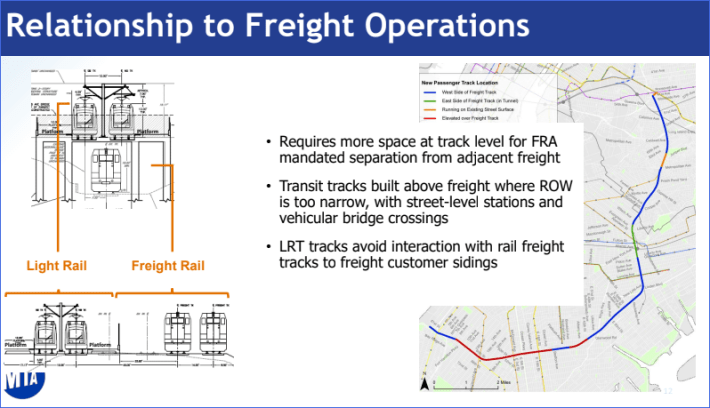
Blank also said that commuter rail cars could also allow for an easier expansion of the Interborough into the Bronx, or at least a way to connect Metro-North trains going from the east Bronx to Queens via the Hell Gate Bridge as part of the the Penn Access project.
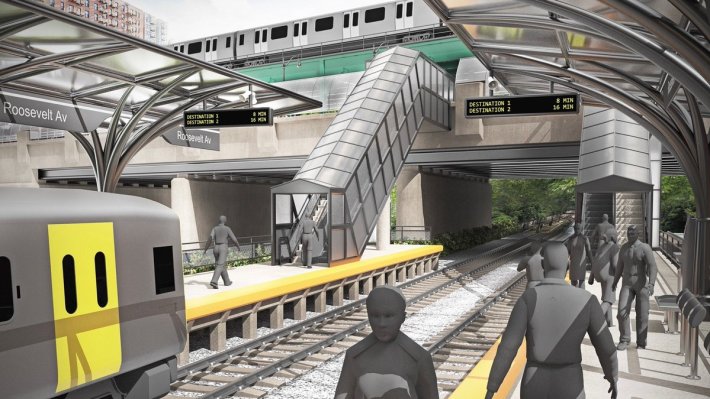
OK, what's this going to cost us?
Of course, as with any big infrastructure project in New York City, the question of costs is one that could ruin the entire party. When the RPA pitched the entire Bay Ridge-to-Bronx project in 2018, the organization said it could be done for $2 billion. Lieber told reporters on Thursday that he predicted the entire thing would cost "in the single digit billions" of dollars, leaving a range between $1,000,000,000 and $9,999,999,999.99. Experts on transit construction costs hesitated to slap an exact number on the project, but did say different aspects of it could help keep the price down or raise the price.
For starters, a right-of-way that dates back to 1876 removes a lot of eminent domain and political headaches.
"That takes away perhaps the biggest sort of procedural headaches in terms of eminent domain, or trying to figure out a way not to piss everyone off, which is not always necessarily the biggest cost in terms of dollars. but it's a huge cost, maybe in terms of political capital, right," said Eric Goldwyn, an associate professor of transportation and land-use program at the NYU Marron Institute and a member of transit analyst organization Transit Costs Project. "You need to get local electeds to say, 'Okay, fine, like, this person's going to scream at me for X, Y, or Z reasons and I'll take the heat for that.'"
Politically, Hochul has already nabbed the support of Queens Borough President Donovan Richards and Brooklyn Borough President Antonio Reynoso, both of whom attended Thursday's press conference to say nice things about the IBX and the governor.
Building on the existing right-of-way, at-grade and not having to build elevated structures are all things that can help keep costs down, Goldwyn said. It's also cheaper to build further away from the center of the city, which would help prevent the kind of cost inflation that's dogged the Second Avenue subway.
But Goldwyn pointed that the MTA will surely find some unexpected challenges in the ancient right-of-way that has degraded while population boomed around it, though he said none of those unexpected bits should be insurmountable challenges.
What could drive up costs though, are the train stations that need to be built for the riders of the IBX. In addition to the existing right-of-way, the other appealing aspect of the Interborough Express is that it runs near 17 subway lines between Bay Ridge and Jackson Heights: the A, B, C, D, E, F, J, L, M, N, Q, R, Z, 2, 3, 5 and 7. But Goldwyn pointed out that a train running near a subway line doesn't automatically connect to that line until the connection is actually built.
"How many stations do you build? What kind of stations do you tie into the existing subway stations? At Broadway Junction for instance, it's something like 1,000 feet away. That's a really important transfer, you really want to make sure Broadway Junction is served by the Interborough. So how do you square that circle? It's not impossible, but it might require more structural work than just a platform and a box," he said.
Goldwyn cautioned the MTA against going full artisan on the stations themselves.
"Do we want to have bespoke stations that are expensive? Or do we want to have really cheap stations that allow us to build this project within some budget and quickly? Those are political decisions, and there's no technical reason, I don't think, to do one versus the other necessarily," he said.
"Are they going to opt for fancy customized stations to reflect the neighborhood context? Or are they going to say, we're going to make the same box every 2,000 feet and call it a day? There can be something in between those two outcomes, too. But one of the ways that you keep costs low is to have the most modular, reproducible design that you can have."
Station inflation was something Goldwyn said said helped doom the Green Line extension project in Boston, which was a similar attempt to reactivate a dormant right-of-way in Beantown.
"In Boston, when they got through a final design, it fell apart in part because the estimate went from just under $1 billion to around $3 billion. In the initial plan, the design for the stations was just above ground, at-grade and a simple weather shelter, platform, ramp, that kind of thing. By the time, everything got done and redesigned, you had stations that were in the tens of millions of dollars, because they had elevators and restrooms, and a lot of amenities. Maybe that's okay, but it's a discussion that needs to be made," he said.
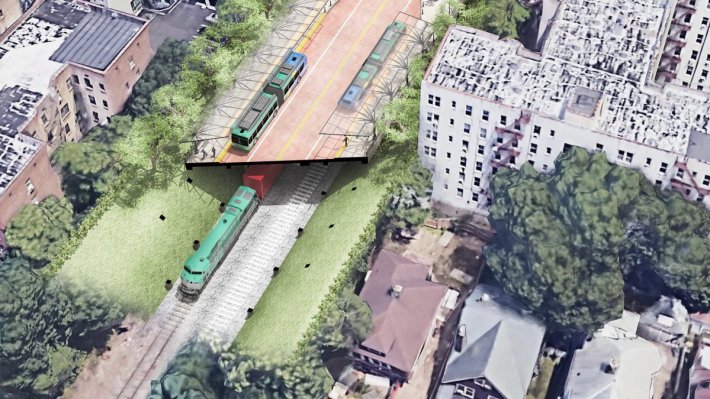
Project boosters say that the Interborough is a big opportunity for the MTA to show the world that it knows how to work fast and keep costs down somewhere in a realm that doesn't lead to speculation organized crime is still running the construction industry in New York City.
"The big question is after [the environmental review] process, is how fast can this get built? The right-of-way is there, the tracks are there. Is this a place where the MTA will be able to show that it's advancing projects at a faster clip and under budget?" Slevin said.
Are we there yet?
These and other questions and issues will be tackled when the MTA puts out its preliminary scope of the projects, and lurches towards the formal environmental review process under the National Environmental Policy Act, otherwise known as NEPA. An MTA spokesperson previously said the formal NEPA process should take less than two years once it starts. But, before NEPA even starts, the MTA's plan is to review the project with the public and stakeholders and finish an analysis to turn into the environmental review. If and when the agency gets the go-ahead from the federal government to build New York City's next great rail project, Lieber said that the construction would take somewhere between three and five years.

Until then, you're either taking the G, the bus or trudging into Manhattan to move north and south between Queens and Brooklyn. But maybe your kids will never know such hardship.
Dave Colon is a reporter from Long Beach, a barrier island off of the coast of Long Island that you can bike to from the city. It’s a real nice ride. He’s previously been the editor of Brokelyn, a reporter at Gothamist, a freelance reporter and delivered freshly baked bread by bike. Dave is on Twitter as @davecolon. Email Dave Colon at dcolon@streetsblog.org
Read More:
Stay in touch
Sign up for our free newsletter
More from Streetsblog New York City
New York City to Install 500 Secure Bike Parking Hubs In The Next Five Years: Sources
Your bike may finally get a roof over its head.
Adams Backs Lower Speed Limits, Calls Crashes ‘Accidents’
The mayor wants New York City drivers to "slow down," but it's not clear yet how many streets will get lower speed limits.
Wednesday’s Headlines: Trump Posts About Congestion Pricing Edition
Donald Trump comments on congestion pricing — no surprise, he's against it. Plus more news.
DOT Aims to Build First Ave. Tunnel Bike Lane Before September’s UN General Assembly
DOT hopes to have the concrete-protect tunnel bike lane installed this summer, but its exact plans are still in development.
Waste Reforms Could Require Data on Crashes, Dangerous Driving
The proposal affects at least one trucking company with a deadly driving record.




